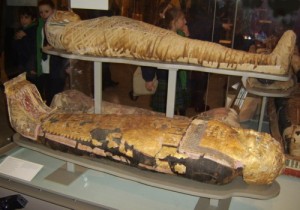Religion was very important in ancient Egyptian civilization. Their belief in the rebirth after death became their driving force behind their funeral practices. These funerary practices and customs were meant for the preservation of the body and continuation of life after death.
The Death Rituals practiced by the Ancient Egyptians included embalming and mummification. The mummies of dead Egyptians were placed in anthropoid coffins which were decorated with a likeness of the deceased. The coffins were then placed in a protective stone sarcophagus. There were other extremely important death rituals which were practiced including the ‘Opening of the Mouth ‘ ritual.
The Egyptians saw death as a transitional stage in the progress to a better life in the next world. The Egyptians believed a person has three souls- the “ka,” the “ba,” and the “akh.” The Ka meant Dynamic and impersonal life force. The ba meant animation or manifestation, something akin to the idea of a soul. The akh meant transfigured spirit into which the dead were transformed.
Mummification became a significant aspect of ancient Egyptian Funeral practices and religion, not only for the pharaoh and nobles but for the general population. It was an intricate combination of ritual and science. However, only the privileged social classes could afford the best and most elaborate funeral.
There were paintings depicting scenes of idealized life on the walls of the tomb. For example, there were scenes of agricultural work such as harvesting crops, tending cattle and fishing, scenes of artisans at their work, including gold workers and boat-builders and domestic scenes of banquets with musicians, dancers, and guests. Other important funerary items were the Canopy Jars and Ushabti.

As the process of mummification ends, the final journey of the mummy to its tomb (house of eternity) begins. On crossing the Nile the Egyptian Funeral procession made its way to the ‘Wabet’ – additional purification may have taken place here (if the body had never been returned to its family, then the full mummification procedure may have been performed here).
As the life is continued after death, therefore, all the necessary things required for life were packed in the tomb. Objects played a major part in ancient Egyptian funerary customs. The earliest of these were containers holding food and throughout Egyptian history nourishment, without which there was no hope for eternal life, remained essential, and it was generally the duty of the eldest son to supply it to his parents.